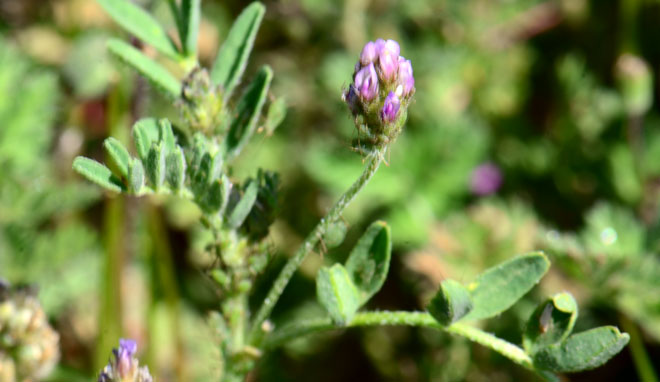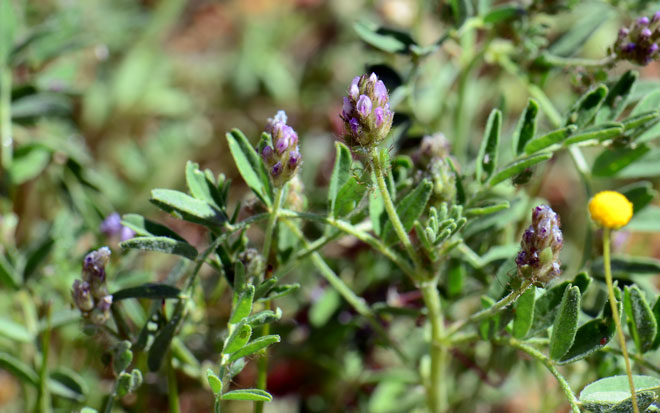Astragalus didymocarpus, Dwarf White Milkvetch


Scientific Name: Astragalus didymocarpus
Common Name: Dwarf White Milkvetch
Also Called: Locoweed, Miles' Milk-vetch, Rattleweed, Two Seeded Milkvetch, (Spanish: Hierba Loca, Cascabelito)
Family: Fabaceae or Leguminosae Family
Synonyms: ()
Status: Native
Duration: Annual
Size: 1 foot (30 cm) or more.
Growth Form: Dwarf White Milkvetch is a slender, grayish forb/herb with multiple branches; stems are low lying (prostrate) and spreading; the plants are covered with short fine grayish hairs (pubescence).
Leaves: Dwarf White Milkvetch has green leaves which are are pinnately compound; the shape of the leaflets is variable.
Flower Color: Dwarf White Milkvetch has white and purple or whitish with purple; the fruit is a small round pod becoming papery as it dries.
Flowering Season: February to April; variety "milesianus" blooms March to June in California.
Elevation: 1,000 to 2,500 feet (305 - 762 m).
Habitat Preferences: Lower desert areas, open rocky areas, gravelly or sandy soil.
Recorded Range: Somewhat rare in the United States where it is native to AZ, CA and NV. It is also native to Baja California. In Arizona it occurs in northern Mojave, Maricopa, Pinal and Pima Counties; in California it is found throughout most of the southern part of the state and in Nevada it occurs in the central and southern parts of the state.
North America & US County Distribution Map for Astragalus didymocarpus.
U.S. Weed Information: Unknown
Invasive/Noxious Weed Information: Unknown
Wetland Indicator: Unknown
Threatened/Endangered Information: The variety Astragalus didymocarpus var. milesianus, Miles' Milk-vetch is listed by the California Native Plant Society as "Rare or Endangered" and the plants are "Threatened by development".
The genus was published in 1753 by Carl Linnaeus, (1707-1778).
In the Southwestern United States: Arizona has 160 species of Astragalus, California has 180 species, Nevada has 189 species, New Mexico has 139 species, Texas has 60 species, Utah has 205 species. Data approximate, subject to revision.
4 varieties in Astragalus didymocarpus:
Astragalus didymocarpus var. didymocarpus, Dwarf White Milkvetch, (CA, NV);
Astragalus didymocarpus var. dispermus, Dwarf White Milkvetch, (AZ, CA, NV);
Astragalus didymocarpus var. milesianus, Miles' Milk-vetch, (CA only);
Astragalus didymocarpus var. obispoensis, San Obispo Milkvetch, (CA only).
Comments: Dwarf White Milkvetch is an inconspicuous plant found in lower Sonoran Desert elevations. The type specimen Astragalus didymocarpus var. dispermus was collected by Palmer in 1876 from Wickenburg, Maricopa Co., AZ.
Also see in Southwest Desert Flora; Arizona Milkvetch, Astragalus arizonicus and Ashen Milkvetch, Astragalus tephrodes.
Dwarf White Milkvetch, Astragalus didymocarpus has attractive flowers, the flowers and their plants may be visited by butterflies, moths, flies, honeybees, Native Bees and other insects in search of food and nectar.
The genus Astragalus was published in 1753 by Carl Linnaeus, (1707-1778).
The species epithet “didymocarpus” (didymocar'pus:) means with the fruit in pairs.

